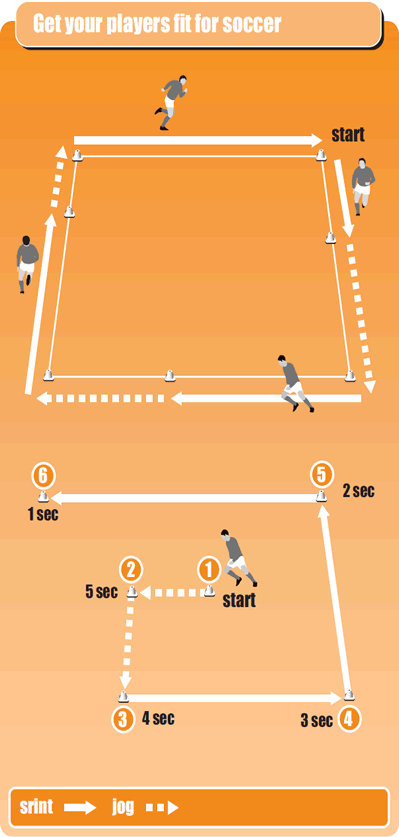Do you want to play football better, faster, and longer without getting tired? Improving your fitness is the key to unlocking your true potential on the field.
Whether you’re a beginner or a seasoned player, boosting your strength, speed, and endurance can make a huge difference in your game. You’ll discover simple and effective ways to take your football fitness to the next level. Keep reading, and get ready to see real results that will help you dominate every match.

Credit: www.youtube.com
Football Fitness Basics
Football fitness is the foundation for every player’s success. It shapes how you perform on the field. Improving fitness means working on strength, speed, and endurance. These basics prepare your body for the demands of football. Training smart helps you avoid injuries and recover faster.
Key Physical Attributes
Speed is vital for quick sprints and chasing the ball. Strength helps in tackles and maintaining balance. Endurance keeps energy high throughout the game. Agility allows sharp turns and quick moves. Coordination improves ball control and passing accuracy. Flexibility reduces muscle tightness and injury risk.
Common Fitness Challenges
Fatigue can lower your performance during games. Lack of strength leads to weak tackles and falls. Poor endurance makes you tire fast. Slow recovery delays your next training session. Imbalance in muscle strength causes injuries. Inconsistent training stops steady progress.

Credit: www.soccercoachweekly.net
Effective Warm-up Routines
Effective warm-up routines prepare the body and mind for football training or matches. They reduce injury risk and improve performance. A good warm-up increases blood flow, loosens muscles, and activates key movements. This section explains two vital parts: dynamic stretching and pre-game activation drills.
Dynamic Stretching Techniques
Dynamic stretching uses controlled movements to stretch muscles. It helps increase flexibility and mobility without lowering muscle power. Examples include leg swings, arm circles, and walking lunges. These stretches mimic football movements and prepare muscles for quick actions. Dynamic stretching raises body temperature and heart rate safely. Avoid holding stretches for long times. Move smoothly and steadily through each stretch.
Pre-game Activation Drills
Activation drills wake up muscles and nervous system before playing. They improve speed, balance, and coordination. Common drills are high knees, butt kicks, and quick side shuffles. These exercises boost muscle responsiveness for sudden sprints and changes in direction. Keep drills short and intense, about 10-15 seconds each. Rest briefly between drills to maintain energy. Activation drills sharpen focus and prepare the body for peak effort.
Strength Training Essentials
Strength training is key to improving football fitness. It builds power, speed, and injury resistance. Focus on exercises that target muscles used most in football. Train smart and stay consistent to see progress.
Core Muscle Groups
The core muscles support almost every football move. Strong abs, lower back, and hips improve balance and stability. These muscles help with quick turns and strong tackles. Exercises like planks, bridges, and leg raises strengthen your core. A solid core reduces injury risk and boosts performance.
Functional Exercises For Football
Functional exercises mimic football movements. They improve strength and coordination. Squats, lunges, and deadlifts build leg power for running and jumping. Push-ups and pull-ups develop upper body strength for blocking and tackling. Use bodyweight or light weights to stay agile. These exercises prepare the body for real game action.
Speed And Agility Drills
Speed and agility are key skills for football players. Improving these skills helps players move faster and change direction quickly. Speed and agility drills train muscles and improve coordination. These drills also boost balance and reaction time. Practicing them regularly makes players more confident on the field.
Sprint Workouts
Sprint workouts build explosive power and increase running speed. Short sprints, like 10 to 40 meters, help develop fast-twitch muscles. Rest between sprints allows full recovery for maximum effort. Sprint intervals improve endurance and speed together. Focus on strong starts and quick acceleration. Maintain good posture and drive your knees high. Sprint drills simulate real football movements for better game performance.
Ladder And Cone Drills
Ladder and cone drills enhance footwork and agility. Use an agility ladder to practice quick steps and coordination. Move both feet inside each square without touching the ladder. Cone drills improve sharp turns and body control. Set cones in different patterns for side steps and zigzags. These drills train brain and body to react fast. Better footwork helps avoid defenders and improve game skills.
Endurance Building Strategies
Building endurance is key for football players. Good stamina helps you run, tackle, and recover faster. It keeps your energy up through the whole match. Endurance training improves heart and lung strength. This means you can play harder and longer without getting tired. Focus on two main strategies: interval training and long-distance conditioning.
Interval Training
Interval training means alternating between fast and slow exercises. Sprint hard for a short time. Then walk or jog to recover. Repeat this cycle several times. This method boosts your heart rate quickly. It trains your body to recover fast after bursts of effort. Interval training mimics the stop-and-go nature of football. It also improves speed and power. Try sprinting for 30 seconds, then walking for 1 minute. Do this 6 to 8 times in a session.
Long-distance Conditioning
Long-distance conditioning builds steady stamina. Run or jog at a comfortable pace for 20 to 40 minutes. This strengthens your heart and lungs over time. It helps you stay active without feeling tired. This training supports your body’s ability to work longer. It also aids muscle endurance and mental toughness. Aim for 3 to 4 sessions each week. Keep your pace easy enough to talk but steady enough to sweat.

Credit: jenkinstherapy.com
Flexibility And Mobility
Flexibility and mobility are key to better football fitness. They help players move freely and react quickly on the field. Good flexibility reduces muscle tightness and improves joint movement. This lets players run, jump, and change direction faster. Mobility supports strong and safe body movements. Together, they lower injury risk and boost overall performance.
Stretching Routines
Stretching improves muscle length and joint range. Start with dynamic stretches before practice. Leg swings, arm circles, and lunges warm up the body. After training, use static stretches to relax muscles. Hold each stretch for 20 to 30 seconds. Focus on the hamstrings, calves, hips, and shoulders. Regular stretching keeps muscles flexible and ready for action.
Injury Prevention Tips
Proper flexibility and mobility help prevent injuries. Tight muscles cause strains and tears. Warm up muscles with light jogging or skipping. Include balance and strength exercises in your routine. Use foam rollers to release muscle knots. Avoid sudden intense movements without warming up. Listen to your body and rest if needed. Consistent care keeps you on the field longer.
Nutrition For Peak Performance
Nutrition plays a key role in football fitness. Eating the right foods helps your body perform well. Proper nutrition supports energy, strength, and recovery. Fuel your body wisely to get the best results on the field.
Pre-training Meals
Eat a balanced meal 2 to 3 hours before training. Focus on carbohydrates like rice, pasta, or bread. Add some protein such as chicken, fish, or beans. Avoid heavy fats and large portions that cause discomfort. This meal gives steady energy during practice. A small snack 30 minutes before can boost energy. Try a banana or a small yogurt cup.
Hydration Guidelines
Water is vital for football fitness. Drink water throughout the day, not just during training. Aim to drink 16 to 20 ounces two hours before exercise. Sip 7 to 10 ounces every 10 to 20 minutes during activity. Replace lost fluids after training with water or sports drinks. Proper hydration keeps muscles working and prevents cramps. Watch for signs of dehydration like tiredness or dizziness.
Recovery Techniques
Recovery techniques help football players repair their muscles and regain energy. Proper recovery reduces the risk of injury and improves overall fitness. Using the right methods helps players stay strong and ready for training or matches. Focus on rest and active recovery to get the best results.
Rest And Sleep
Rest is the simplest way to help your body heal. Sleeping enough allows muscles to recover and grow stronger. Aim for 7 to 9 hours of sleep every night. Avoid screens before bed to improve sleep quality. Short naps during the day can also refresh your energy. Never skip rest days in your training schedule. Your body needs time to fix tiny muscle tears.
Active Recovery Methods
Active recovery means doing light exercises after intense workouts. Activities like walking, cycling, or swimming help blood flow to muscles. This flow removes waste and brings nutrients to speed healing. Stretching keeps muscles flexible and lowers soreness. Foam rolling can reduce muscle tightness and improve movement. Keep active recovery sessions easy and short. They prepare your body for the next hard training or match.
Tracking Progress
Tracking progress is key to improving fitness for football. It helps you see how far you have come. It also shows what needs more work. Without tracking, it is easy to lose motivation or miss weak points. Keep records of your training results and fitness tests. This helps make your workouts smarter and more effective.
Fitness Testing
Fitness testing measures your current physical level. Common tests include sprint times, endurance runs, and strength checks. Test regularly to compare results over time. Use simple tools like stopwatches and measuring tapes. Write down scores for each test. This gives clear data to track improvement. Testing reveals your strengths and weaknesses. Focus your training on areas needing the most work.
Setting Realistic Goals
Set clear and realistic goals based on your test results. Small, achievable targets keep you motivated. For example, improve your sprint time by 0.2 seconds. Or run an extra 200 meters without stopping. Goals should be specific and time-bound. Check your progress weekly or monthly. Adjust goals if needed to stay challenged but not overwhelmed. Realistic goals guide your training and boost confidence.
Frequently Asked Questions
How Can I Boost Endurance For Football Training?
Improving endurance requires consistent cardiovascular exercises like running and cycling. Interval training enhances stamina and recovery. Proper hydration and nutrition support endurance. Rest and sleep help the body recover for better performance during football training sessions.
What Are The Best Strength Exercises For Football Players?
Focus on compound movements like squats, deadlifts, and bench presses. These build overall muscle strength and power. Plyometric exercises improve explosive speed. Strength training should target legs, core, and upper body for balanced football fitness.
How Important Is Flexibility In Football Fitness?
Flexibility reduces injury risk and improves movement efficiency. Stretching regularly enhances muscle elasticity and joint mobility. Incorporate dynamic stretches before training and static stretches post-workout to maintain optimal flexibility for football.
How Often Should I Train To Improve Football Fitness?
Aim for 4-5 training sessions weekly, balancing intensity and recovery. Include cardio, strength, and flexibility workouts. Rest days are crucial to prevent burnout and injuries. Consistency and gradual progression yield the best football fitness results.
Conclusion
Improving fitness for football takes time and effort. Focus on strength, speed, and endurance regularly. Practice drills that build agility and coordination. Eat healthy foods to fuel your body well. Rest enough to help muscles recover. Stay consistent with your training every week.
Small steps lead to better performance on the field. Enjoy the process and keep pushing forward. Your hard work will show in your game. Keep training smart and stay motivated. Football fitness improves with patience and dedication.
